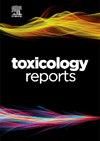深草根和叶提取物的抗氧化活性和急性毒性比较研究
Q1 Environmental Science
引用次数: 0
摘要
齐齐夫斯·阿比西尼亚。答案:a。这是一种埃塞俄比亚传统药用植物,研究了其植物化学成分、抗氧化潜力和急性毒性,以验证其民族药理学用途。经正己烷-水连续溶剂萃取,甲醇和乙酸乙酯组分表现出较好的抗氧化活性(DPPH EC50: 12.5 ± 0.8 μg/mL; abt EC50: 15.2±1.0 μg / mL),相关高酚(120.5 ±0.7 mg GAE / g)和类黄酮(85.6 ±0.6 mg QE / g)的内容。在各种分析中,叶子的表现始终优于根,这反映了组织特异性代谢专业化。全面的植物化学分析显示生物碱、皂苷和苷,定量分析显示溶剂依赖性代谢物恢复。根据经济合作与发展组织(OECD)指南425,2000mg /kg的急性毒性试验显示没有死亡或显著的生化改变,尽管在组织学上观察到轻微的肝脏空泡化。该研究强调了Z. abyssinica作为天然抗氧化剂的双重承诺,具有良好的安全性,同时为其评估建立了标准化的协议。这些发现将传统知识与科学验证联系起来,支持其在针对氧化应激相关病理的营养或治疗应用方面的潜在发展。本文章由计算机程序翻译,如有差异,请以英文原文为准。
Antioxidant activity and acute toxicity of ziziphus abyssinica extracts: A comparative study of root and leaf extracts
Ziziphus abyssinica Hochst. ex A. Rich., a traditionally valued Ethiopian medicinal plant, was investigated for its phytochemical composition, antioxidant potential, and acute toxicity to validate its ethnopharmacological uses. Through sequential solvent extraction (n-hexane to aqueous), methanol and ethyl acetate fractions of leaves exhibited superior antioxidant activity (DPPH EC50: 12.5 ± 0.8 μg/mL; ABTS EC50: 15.2 ± 1.0 μg/mL), correlating with high phenolic (120.5 ± 0.7 mg GAE/g) and flavonoid (85.6 ± 0.6 mg QE/g) content. Leaves consistently outperformed roots across assays, reflecting tissue-specific metabolic specialization. Comprehensive phytochemical profiling revealed alkaloids, saponins, and glycosides, with quantitative analysis demonstrating solvent-dependent metabolite recovery. Acute toxicity testing using Organization for Economic Co-operation and Development (OECD) Guideline 425, at 2000 mg/kg showed no mortality or significant biochemical alterations, though mild hepatic vacuolization was observed histologically. The study highlights Z. abyssinica’s dual promise as a source of natural antioxidants with a favorable safety profile, while establishing standardized protocols for its evaluation. These findings bridge traditional knowledge with scientific validation, supporting its potential development for nutraceutical or therapeutic applications targeting oxidative stress-related pathologies.
求助全文
通过发布文献求助,成功后即可免费获取论文全文。
去求助
来源期刊

Toxicology Reports
Environmental Science-Health, Toxicology and Mutagenesis
CiteScore
7.60
自引率
0.00%
发文量
228
审稿时长
11 weeks
 求助内容:
求助内容: 应助结果提醒方式:
应助结果提醒方式:


